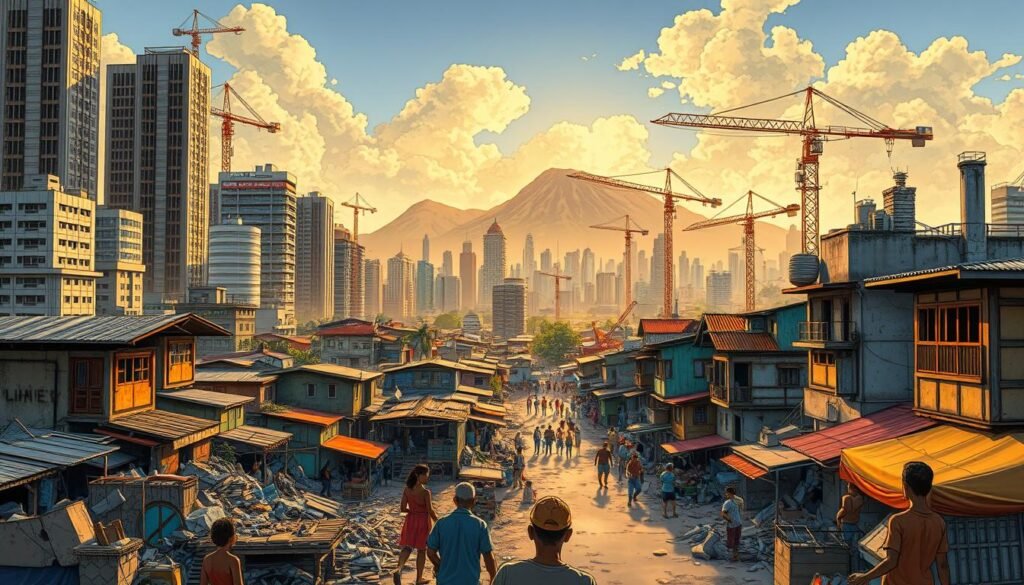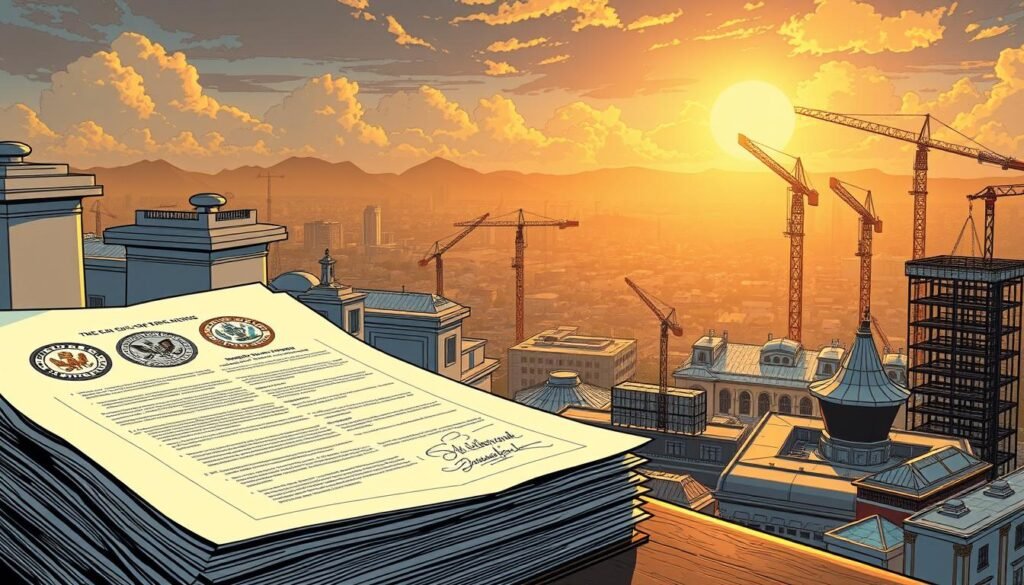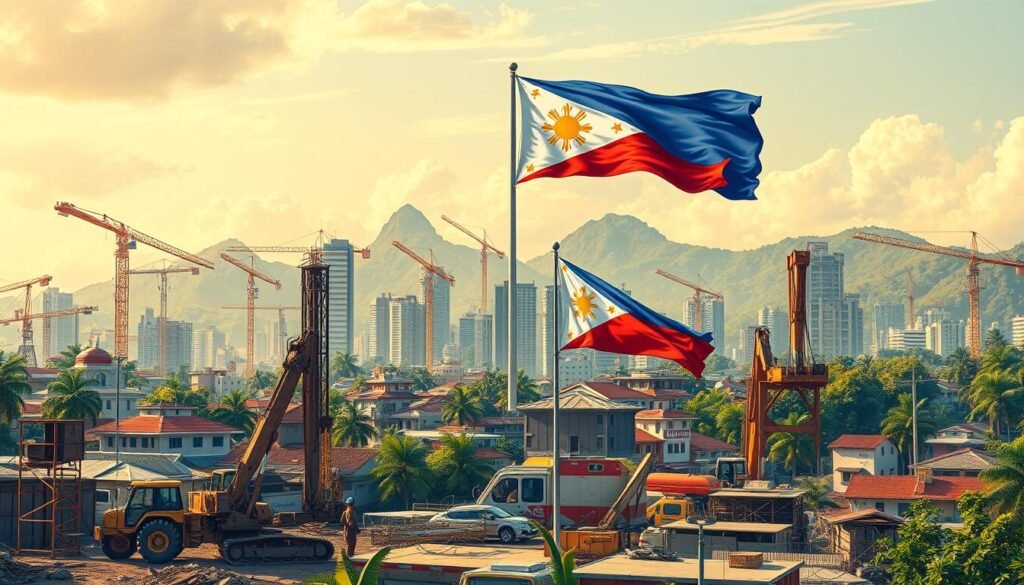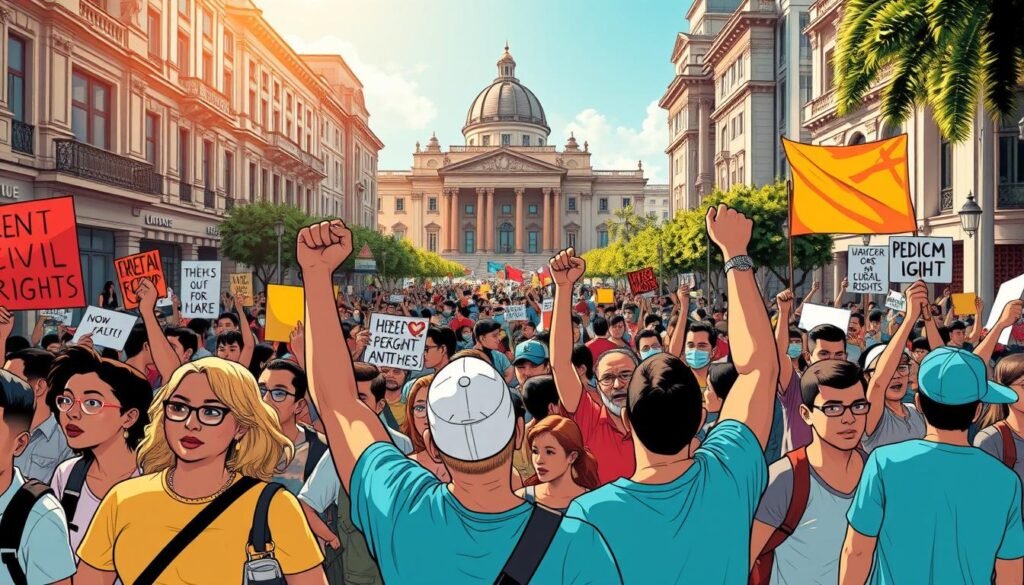The aftermath of conflict often leaves nations in disarray, requiring immense effort to rebuild. The Philippines faced such a challenge after its own civil war, with the need to restore infrastructure, governance, and social systems. This process, akin to the reconstruction efforts seen in the southern states of the U.S., was critical for the nation’s recovery.
Rebuilding after war is not just about physical structures. It involves re-establishing trust, creating sustainable systems, and ensuring long-term stability. The Philippines’ journey highlights the importance of historical continuity and the lessons learned from past recovery plans.
This article explores the multifaceted approach to reconstruction, the challenges faced, and the strategies that helped the nation move forward. From economic reforms to social initiatives, the Philippines’ story offers valuable insights into the resilience of a nation determined to rise again.
Key Takeaways
- Post-war rebuilding requires restoring infrastructure, governance, and social systems.
- The Philippines’ reconstruction efforts mirrored historical methods used in the U.S.
- Challenges included economic instability and displaced populations.
- Recovery plans emphasized long-term stability and sustainability.
- Lessons from the Philippines offer insights into effective post-conflict recovery.
Introduction to Post-War Reconstruction in the Philippines
The end of war marks the beginning of a nation’s journey to rebuild its foundations. For the Philippines, the aftermath of World War II presented immense challenges. The conflict left the country’s infrastructure in ruins, its government in disarray, and its social fabric torn apart. Rebuilding was not just about repairing physical damage but also restoring trust and stability.
Major events, such as the Japanese occupation and the subsequent liberation, necessitated urgent recovery efforts. The war claimed over 1 million lives and displaced countless others. The Philippine Commonwealth, established in 1935, faced the daunting task of transitioning to full independence while addressing these crises.

The impact of the war was profound. Infrastructure, including roads, bridges, and public buildings, was destroyed. The government struggled to re-establish authority, and social systems were disrupted. The state had to balance immediate needs with long-term planning to ensure sustainable recovery.
Local and international influences played a significant role in shaping reconstruction policies. The United States, through initiatives like the Rehabilitation Bill, provided financial aid and technical support. However, the Philippines also had to navigate complex political dynamics, such as the Bell Trade Act, which extended free trade relations but imposed long-term economic conditions.
Understanding the Philippines’ post-war recovery offers valuable insights into modern reconstruction strategies. It highlights the importance of collaboration, strategic planning, and resilience in overcoming the challenges of rebuilding a nation.
| Key Challenges | Strategies |
|---|---|
| Destroyed infrastructure | Prioritized rebuilding roads, bridges, and public buildings |
| Displaced populations | Implemented resettlement programs and social support systems |
| Economic instability | Secured international aid and focused on trade agreements |
| Political uncertainty | Strengthened governance and transitioned to full independence |
Historical Context of the Philippine Conflict and its Aftermath
The Philippines’ history is marked by a series of conflicts that shaped its path to recovery. From the Spanish colonization to the Japanese occupation during World War II, the nation faced immense challenges. The war left the country in ruins, with infrastructure destroyed and millions displaced. Understanding this historical backdrop is crucial to grasp the urgency of post-war recovery efforts.
The immediate aftermath of the conflict saw a nation in disarray. Roads, bridges, and public buildings were reduced to rubble. The government struggled to re-establish authority, and social systems were in chaos. The need for a comprehensive plan to rebuild was evident. This period required not just physical restoration but also the re-establishment of trust and stability among the population.
The challenges were immense. Over 1 million lives were lost, and countless families were displaced. The Philippine Commonwealth, established in 1935, faced the daunting task of transitioning to full independence while addressing these crises. The time was ripe for strategic action, but the path forward was fraught with obstacles.
Comparable historical contexts, such as the U.S. post-war transformation, highlight the importance of timely and strategic planning. Both nations faced the dual challenge of rebuilding infrastructure and restoring social order. The Philippines’ experience underscores the value of collaboration and resilience in overcoming such monumental tasks.
“Rebuilding after war is not just about physical structures; it’s about restoring hope and stability.”
The timeline of events reveals the complexity of the situation. From the Japanese occupation to the liberation by Allied forces, each phase brought new challenges. The government had to balance immediate needs with long-term goals, ensuring that recovery efforts were sustainable. This historical context provides valuable lessons for modern recovery strategies.
The Foundations of Rebuilding a Nation
Rebuilding a nation after war demands a strong foundation rooted in unity and strategic planning. For the Philippines, this meant creating a blueprint that addressed both immediate needs and long-term goals. The process involved re-establishing trust, ensuring civil rights, and implementing structured governance.
One of the key principles was embedding civil rights into the recovery framework. This ensured that all citizens, regardless of their background, had equal opportunities. The Philippines drew inspiration from historical examples, such as the United States’ post-war transformation, to shape its policies.

Institutional reforms played a critical role in laying a stable foundation. Legislation was introduced to strengthen governance and promote transparency. These reforms were essential for restoring public confidence and ensuring sustainable progress.
Comparing the Philippines’ approach to the Reconstruction Acts of the United States highlights the importance of adaptive strategies. Both nations prioritized structural reforms and civil rights, but the Philippines tailored its policies to address its unique challenges.
“A nation’s strength lies in its ability to rebuild with fairness and resilience.”
Key structural reforms included rebuilding infrastructure, resettling displaced populations, and fostering economic stability. These efforts were supported by international aid and local initiatives, creating a balanced approach to recovery.
The early phases of rebuilding set the stage for long-term success. By focusing on foundational principles, the Philippines ensured that its recovery efforts were both effective and inclusive. This approach offers valuable lessons for modern nations facing similar challenges.
Global Influences on Post-War Recovery Strategies
Global trends and international examples played a pivotal role in shaping the Philippines’ post-war recovery. The nation looked beyond its borders for strategies to rebuild its economy, infrastructure, and social systems. This approach was not unique; many countries, including the former Confederate states in the U.S., relied on global models to guide their recovery.
One significant influence was the Freedmen’s Bureau, a U.S. initiative that provided aid to newly freed African Americans after the Civil War. Similarly, the Philippines adapted international programs to address its own challenges. These included resettling displaced populations and rebuilding critical infrastructure.

International aid also played a crucial role. Programs like the Marshall Plan, which helped rebuild Europe after World War II, inspired similar efforts in the Philippines. Financial and technical support from countries like the U.S. accelerated the recovery process. However, the Philippines tailored these global strategies to fit its unique needs.
“Global recovery models provided a blueprint, but local adaptation was key to success.”
Key global trends that influenced the Philippines’ recovery included:
- Economic reforms inspired by post-war recovery in South Carolina and other regions.
- Social programs modeled after international initiatives to support displaced populations.
- Political reforms that drew from global examples of governance restructuring.
By learning from global experiences, the Philippines ensured its recovery efforts were both effective and sustainable. This approach highlights the importance of collaboration and adaptability in rebuilding a nation after conflict.
Key Reconstruction Policies and Legislation
The process of rebuilding a nation after war involves a mix of strategic policies and legal reforms. In the Philippines, this meant creating a framework that addressed immediate needs while laying the groundwork for long-term stability. Government initiatives and legal reforms played a crucial role in shaping the recovery process.

Government Initiatives and Programs
One of the primary focuses was rebuilding infrastructure and public services. Programs were launched to restore roads, bridges, and public buildings. These efforts were essential for reconnecting communities and reviving the economy.
Another key initiative was resettling displaced populations. The government implemented programs to provide housing and social support. This helped restore stability and trust among affected communities.
Economic reforms were also a priority. The Philippines secured international aid and focused on trade agreements to boost recovery. These measures were critical for addressing economic instability and fostering growth.
Legal and Structural Reforms
Legal reforms aimed to strengthen governance and ensure accountability. New legislation was introduced to promote transparency and fairness. These changes were vital for restoring public confidence in the government.
Structural reforms included measures to modernize institutions. The Philippines drew inspiration from global examples, such as the Freedmen’s Bureau in the U.S., to shape its policies. These reforms helped create a more resilient and inclusive system.
Key legislative acts, similar to the Reconstruction Acts in the south, were implemented to guide the recovery process. These acts provided a framework for rebuilding and ensured that reforms were sustainable.
| Policy/Reform | Objective |
|---|---|
| Infrastructure Restoration | Rebuild roads, bridges, and public buildings |
| Resettlement Programs | Provide housing and support for displaced populations |
| Economic Reforms | Secure international aid and boost trade |
| Legal Reforms | Strengthen governance and ensure accountability |
| Structural Reforms | Modernize institutions and promote inclusivity |
“Effective recovery requires both immediate action and long-term planning.”
By combining government initiatives with legal and structural reforms, the Philippines created a comprehensive recovery plan. This approach offers valuable lessons for nations facing similar challenges today.
Reconstruction: Defining Post-War Recovery
Defining post-war recovery involves understanding the balance between immediate needs and long-term goals. For the Philippines, this meant addressing the destruction caused by World War II while laying the groundwork for sustainable development. The process mirrored historical efforts in the U.S., where the right to rebuild was a central theme.

In the Philippine context, recovery was not just about physical rebuilding. It also focused on restoring governance, infrastructure, and social systems. The republican ideals of fairness and inclusivity played a key role in shaping policies. These efforts were supported by both local initiatives and international aid.
Key metrics for recovery included:
- Rebuilding roads, bridges, and public buildings.
- Resettling displaced populations and providing social support.
- Strengthening governance and ensuring accountability.
Debates arose over the scope of recovery. Some argued for a focus on immediate relief, while others emphasized long-term sustainability. The congress played a crucial role in balancing these perspectives, ensuring that recovery efforts were comprehensive.
“Effective recovery requires both immediate action and long-term planning.”
The lasting impact of these definitions is evident in the Philippines’ development strategies today. Lessons from this period highlight the importance of collaboration, resilience, and adaptability. For more insights into historical recovery efforts, explore the infrastructure legacy of William Cameron Forbes.
By understanding the complexities of post-war recovery, the Philippines set a precedent for future rebuilding efforts. This approach offers valuable lessons for nations facing similar challenges today.
Socio-Economic Rebuilding and Infrastructure Development
Rebuilding a nation’s economy and infrastructure after war is a monumental task that demands strategic planning and resilience. For the Philippines, the post-war era required addressing socio-economic challenges while laying the foundation for sustainable growth. This process mirrored efforts in the U.S., where leaders like Johnson and Lincoln guided recovery through innovative policies.

The socio-economic challenges were immense. Displaced populations, destroyed industries, and economic instability created a complex landscape. The Philippines prioritized infrastructure projects to modernize transportation, communications, and utilities. These efforts were critical for reconnecting communities and reviving the economy.
Economic policies focused on industrial revival and job creation. Drawing inspiration from the Freedmen initiatives in the U.S., the Philippines implemented programs to resettle displaced workers and foster sustainable growth. These measures not only addressed immediate needs but also laid the groundwork for long-term prosperity.
Key strategies included:
- Rebuilding roads, bridges, and public buildings to restore connectivity.
- Implementing resettlement programs to provide housing and social support.
- Securing international aid and fostering trade agreements to boost economic stability.
“Effective recovery requires both immediate action and long-term planning.”
Bridging economic disparities was another critical focus. The Philippines tailored global strategies to fit its unique needs, ensuring that recovery efforts were inclusive and equitable. Lessons from this period highlight the importance of collaboration, innovation, and resilience in overcoming post-war challenges.
Political Reform and Governance in Post-War Philippines
Political reform became a cornerstone of the Philippines’ recovery after the war. The nation faced the dual challenge of transitioning leadership and restructuring its government to ensure stability and progress. This period marked a significant shift in governance, with a focus on inclusivity and accountability.

Drawing parallels to the U.S. union’s post-war transformation, the Philippines implemented reforms that reshaped its political landscape. These changes were essential for addressing the immediate needs of a war-torn nation while laying the groundwork for long-term prosperity.
Transitioning Leadership and Administration
The post-war era saw a shift in leadership roles as the Philippines transitioned to full independence. Leaders faced the challenge of rebuilding trust and re-establishing authority. This period required adaptability and strategic planning to navigate the complexities of recovery.
Administrations had to balance immediate relief efforts with long-term goals. Programs were introduced to address displaced populations and restore public services. These initiatives were critical for fostering stability and confidence among citizens.
Institutional Reforms for a New Era
Institutional reforms played a pivotal role in shaping the Philippines’ post-war governance. New policies were introduced to promote transparency and strengthen democratic principles. These reforms ensured that the government was accountable to its citizens.
Key legislative changes included the devolution of power to local administrations. This approach mirrored the U.S. civil rights movement, emphasizing fairness and inclusivity. By decentralizing authority, the Philippines created a more resilient and responsive governance system.
“Effective governance requires both strong leadership and inclusive policies.”
The impact of these reforms extended beyond the immediate post-war period. They set the stage for the Philippines’ future political trajectory, fostering a culture of resilience and adaptability. Lessons from this era continue to inform modern governance strategies.
The Impact of International Aid and Policy Support
International aid and policy support played a transformative role in the Philippines’ post-war recovery. The nation faced immense challenges, including destroyed infrastructure and economic instability. External assistance became a cornerstone of its efforts to rebuild and restore stability.
Multilateral support and financial aid were critical in rebuilding national infrastructure. Programs funded by international organizations helped restore roads, bridges, and public buildings. These efforts reconnected communities and laid the foundation for economic revival.

International organizations like the United Nations and the World Bank contributed significantly. Their policy frameworks provided a blueprint for sustainable recovery. The Philippines adapted these global strategies to address its unique challenges, ensuring that aid was used effectively.
International laws and acts also influenced local legal reforms. For example, the Rehabilitation Act in the U.S. inspired similar measures in the Philippines. These reforms strengthened governance and ensured accountability, fostering public trust.
Specific aid programs accelerated recovery. The Marshall Plan, which rebuilt Europe after World War II, served as a model. The Philippines received financial and technical support, enabling it to modernize its economy and infrastructure.
“Global partnerships and strategic policies were key to the Philippines’ successful recovery.”
The outcomes of international support were profound. The Philippines achieved long-term stability and economic growth. Lessons from this period highlight the importance of collaboration and adaptability in post-war recovery.
For more insights into the role of international aid, explore how international aid can shape recovery.
Key contributions of international aid included:
- Rebuilding critical infrastructure to restore connectivity.
- Providing financial and technical support for economic reforms.
- Strengthening governance through legal and policy frameworks.
The lasting impact of international aid is evident in the Philippines’ development today. By leveraging global support, the nation set a precedent for effective post-war recovery.
Civil Rights and Social Reforms in the Recovery Process
The journey toward equality and justice became a defining feature of the Philippines’ post-war recovery. As the nation rebuilt its physical infrastructure, it also sought to restore civil rights and promote social reforms. This period mirrored the U.S. Reconstruction era, where advancements in civil liberties reshaped society.
Key civil rights advancements included the promotion of equality and the protection of individual freedoms. Legislative reforms, such as the expansion of the right to vote, ensured that all citizens could participate in governance. These measures were critical for fostering inclusivity and rebuilding trust in the government.

National leadership played a pivotal role in championing these reforms. The president and other leaders worked to implement policies that addressed systemic inequalities. Programs like the grant of land to displaced families provided economic stability and social support.
The impact of these reforms extended to local communities. By addressing root causes of inequality, the Philippines created a more just and equitable society. These efforts were supported by international models, such as the U.S. Reconstruction, which provided valuable lessons in balancing immediate needs with long-term goals.
“Equality is not just a goal; it is the foundation of a resilient society.”
Key reforms included:
- Expanding voting rights to ensure equal participation in governance.
- Implementing land redistribution programs to address economic disparities.
- Strengthening legal protections for marginalized groups.
| Reform | Impact |
|---|---|
| Voting Rights Expansion | Increased political participation and inclusivity |
| Land Redistribution | Provided economic stability for displaced families |
| Legal Protections | Ensured equality and justice for marginalized groups |
By prioritizing civil rights and social reforms, the Philippines laid the groundwork for a more inclusive and resilient society. These efforts highlight the importance of equality and justice in post-war recovery.
Educational and Cultural Revitalization in a Post-War Society
Rebuilding education and culture became a cornerstone of the Philippines’ recovery, shaping a brighter future for generations. The war had disrupted schools and cultural institutions, leaving a void in societal identity. Efforts to restore these systems were vital for unifying the nation and fostering long-term stability.
Drawing inspiration from American post-war reforms, the Philippines established public school systems to ensure widespread access to education. These schools became hubs for learning and community engagement, empowering citizens to rebuild their lives. Cultural programs were also launched to revive traditions and strengthen national pride.
- Building schools in rural and urban areas to bridge educational gaps.
- Launching cultural festivals to celebrate local heritage and traditions.
- Collaborating with civil society to ensure inclusivity in reforms.
These efforts were not just about restoring the past but also about creating a foundation for future growth. Educational reforms supported broader socio-economic recovery by equipping citizens with skills for new opportunities. Cultural programs fostered a sense of belonging, essential for national unity.
“Education and culture are the pillars of a resilient society, shaping its identity and future.”
Government bodies worked closely with local communities to drive these reforms. This collaboration ensured that initiatives were tailored to meet the unique needs of different regions. The focus on inclusivity and empowerment set the stage for sustainable progress.
For more insights into the role of cultural heritage in post-war recovery, explore how global strategies influenced local reforms.
| Initiative | Impact |
|---|---|
| Public School Systems | Increased access to education and skill development |
| Cultural Festivals | Revived traditions and strengthened national pride |
| Community Collaboration | Ensured inclusivity and tailored reforms |
By prioritizing education and culture, the Philippines laid the groundwork for a more resilient and unified society. These efforts highlight the importance of investing in human capital and cultural identity for long-term recovery.
Overcoming Challenges: Violence, Corruption, and Resistance
Rebuilding after war is fraught with obstacles, from violence to corruption, demanding innovative solutions. The Philippines faced these challenges head-on, striving to create a stable and just society. Addressing these issues required a multifaceted approach, combining policy reforms with grassroots efforts.
Addressing Root Causes
Violence and corruption were deeply entrenched in the post-war Philippines. Local leaders recognized that tackling these issues required addressing their root causes. Anti-corruption measures were implemented to ensure transparency and accountability in governance. These efforts mirrored strategies used during the Andrew Johnson administration in the U.S., where reforms aimed to restore trust in government institutions.
Conflict management programs were also introduced to reduce violence. These initiatives focused on mediation and community dialogue, fostering a culture of peace. By addressing the underlying causes of conflict, the Philippines laid the groundwork for long-term stability.
Community Mobilization and Resilience
Communities played a vital role in overcoming post-war challenges. Grassroots movements emerged, driven by citizens determined to rebuild their lives. These efforts were supported by local leaders and international organizations, creating a united front against corruption and violence.
Resilience became a defining feature of these communities. Programs like civil resistance initiatives empowered citizens to challenge corrupt systems. This bottom-up approach proved effective in fostering accountability and promoting justice.
Historical comparisons highlight the importance of community engagement. In the United States, similar efforts during the Reconstruction era emphasized the role of local leaders in driving change. The Philippines’ experience underscores the value of sustained community involvement in achieving long-term recovery.
“Resilience and unity are the cornerstones of successful post-war recovery.”
Key strategies included:
- Implementing anti-corruption measures to ensure transparency.
- Promoting conflict resolution through community dialogue.
- Empowering grassroots movements to challenge systemic issues.
By focusing on these strategies, the Philippines demonstrated that overcoming post-war challenges requires both policy reforms and community resilience. This approach offers valuable lessons for nations facing similar obstacles today.
Case Studies: Comparative Analysis with U.S. Reconstruction
Examining historical parallels offers valuable insights into effective post-war recovery strategies. The Philippines’ reconstruction efforts after World War II share striking similarities with the U.S. Reconstruction era following the Civil War. Both nations faced the challenge of rebuilding infrastructure, restoring governance, and addressing social inequalities.
Lessons Learned from Past Experiences
The U.S. Reconstruction era provides a blueprint for understanding the complexities of post-war recovery. In the north, efforts focused on integrating formerly enslaved populations into society. Similarly, the Philippines prioritized resettling displaced communities and restoring civil rights. Both contexts highlight the importance of inclusive policies and grassroots engagement.
One key lesson is the role of legislative reforms. In the U.S., the Freedmen’s Bureau played a pivotal role in supporting newly freed individuals. The Philippines adopted similar measures, such as land redistribution programs, to address economic disparities. These strategies underscore the need for comprehensive legal frameworks in post-war recovery.
Identifying Common Themes Across Regions
Several themes emerge when comparing the U.S. and Philippine reconstruction efforts. Both nations faced resistance from entrenched power structures. In the U.S., Southern states opposed reforms aimed at empowering formerly enslaved individuals. In the Philippines, local elites often hindered progressive policies.
Economic recovery was another shared focus. The U.S. prioritized industrial revival, while the Philippines emphasized agricultural development. Both approaches aimed to create sustainable livelihoods for affected populations. These efforts were supported by international aid, demonstrating the value of global collaboration.
“Rebuilding after conflict requires not just resources but also a commitment to justice and equality.”
Key differences also exist. The U.S. Reconstruction was marked by racial tensions, while the Philippines focused on unifying diverse ethnic groups. These distinctions highlight the importance of tailoring strategies to local contexts.
| Aspect | U.S. Reconstruction | Philippine Reconstruction |
|---|---|---|
| Focus | Civil rights for formerly enslaved individuals | Resettlement of displaced populations |
| Economic Strategy | Industrial revival | Agricultural development |
| Challenges | Racial tensions | Ethnic diversity |
For a deeper understanding of global reconstruction models, explore historical case studies that compare post-war efforts across regions. These insights can inform future recovery projects, ensuring they are both effective and inclusive.
Strategic Planning for Long-Term Sustainability
Strategic planning is the cornerstone of any nation’s journey toward long-term sustainability after conflict. For the Philippines, this meant creating a roadmap that balanced immediate recovery with future growth. Drawing inspiration from the former confederate state models, the nation adopted innovative strategies to ensure resilience and prosperity.
Economic Roadmap for Recovery
Economic revitalization was a top priority in the Philippines’ post-war strategy. The government focused on rebuilding infrastructure, fostering trade, and securing international aid. These efforts mirrored the radical reforms seen in other nations, ensuring a robust foundation for sustainable growth.
Key initiatives included:
- Investing in transportation and communication networks to reconnect communities.
- Promoting agricultural and industrial development to create jobs and boost the economy.
- Implementing fiscal reforms to ensure financial stability and attract foreign investment.
Social Development Strategies
Social harmony was equally critical for long-term sustainability. The Philippines introduced programs to address inequality and promote inclusivity. These strategies were guided by the principles of the amendment to ensure fairness and justice for all citizens.
Key social initiatives included:
- Expanding access to education and healthcare to improve quality of life.
- Launching cultural programs to revive traditions and strengthen national identity.
- Empowering local communities to participate in decision-making processes.
“Sustainable recovery requires not just resources but also a commitment to equity and innovation.”
By integrating economic and social strategies, the Philippines set a precedent for effective post-war recovery. These efforts highlight the importance of strategic planning for sustainable business transformation in achieving long-term success.
Innovation and Modern Strategies in Rebuilding Society
Modern innovations are reshaping how societies recover from conflict, blending technology with tradition. From advanced infrastructure projects to digital transformation initiatives, these strategies are setting new standards for post-war recovery. By leveraging cutting-edge tools and forward-thinking policies, nations are building more resilient and sustainable futures.
Traditional recovery methods often focused on physical rebuilding and immediate relief. Today, the integration of technology has revolutionized these approaches. For example, digital platforms are being used to streamline resource distribution and enhance communication in disaster-stricken areas. These innovations not only speed up recovery but also ensure greater transparency and efficiency.
Policy Frameworks and Legislative Reforms
New policy frameworks, including the introduction of a groundbreaking bill, are shaping modern recovery efforts. These reforms emphasize inclusivity and sustainability, ensuring that all citizens benefit from rebuilding initiatives. Drawing parallels to the confederate state models, modern strategies focus on long-term stability rather than short-term fixes.
Constitutional reforms have played a pivotal role in shaping recovery efforts. By embedding principles of equity and justice into the constitution, nations are creating a foundation for lasting peace. These legal changes are complemented by innovative social programs that address the root causes of inequality and conflict.
Modern Infrastructure and Social Programs
Innovative infrastructure projects are at the heart of modern recovery strategies. Smart cities, renewable energy systems, and resilient housing are transforming urban landscapes. These projects not only restore functionality but also prepare communities for future challenges.
Social programs are equally critical. Initiatives like digital literacy campaigns and mental health support services are empowering citizens to rebuild their lives. These programs are designed to foster resilience and ensure that no one is left behind in the recovery process.
“Innovation is not just about technology; it’s about creating systems that empower people and communities.”
| Traditional Methods | Modern Strategies |
|---|---|
| Physical rebuilding | Smart infrastructure and digital tools |
| Immediate relief | Long-term sustainability and inclusivity |
| Manual resource distribution | Digital platforms for efficient allocation |
By embracing innovation and modern strategies, nations are not only recovering from conflict but also building a brighter future. These efforts highlight the importance of adaptability and forward-thinking in achieving long-term success.
Conclusion
The journey of rebuilding after conflict is a testament to resilience and determination. The Philippines’ recovery efforts highlight the importance of sustained government, community, and international collaboration. By integrating historical lessons with modern innovations, the nation has laid a foundation for long-term stability and growth.
Key themes from this article emphasize the need for inclusive policies, strategic planning, and adaptability. From infrastructure development to social reforms, the Philippines’ approach offers valuable insights for nations facing similar challenges. These efforts underscore the significance of learning from the past to shape a brighter future.
As the end of this discussion, it’s clear that recovery is not just about rebuilding structures but also restoring hope and unity. For more on the role of international aid in shaping recovery, explore this resource. Together, we can continue to build a resilient and prosperous society.
FAQ
What was the main goal of post-war reconstruction in the Philippines?
How did global influences shape the Philippines’ recovery strategies?
What were some key policies during the reconstruction period?
How did the Philippines address political reform after the war?
What role did education play in post-war recovery?
What challenges did the Philippines face during reconstruction?
How did international aid impact the Philippines’ recovery?
What lessons were learned from the U.S. reconstruction era?
What strategies were used for economic recovery?
How did the Philippines ensure long-term sustainability?
Source Links
- The Philippines – Six years after conflict, progress and challenges for IDPs
- No title found
- History of the Philippines (1946–1965)
- July 4, 1946: The Philippines Gained Independence from the United States | The National WWII Museum | New Orleans
- History of the Philippines – World War II | Britannica
- Conflict analysis of The Philippines – GSDRC
- History of the Philippines | People, Spain, United States, Revolution, Map, & Facts | Britannica
- Spanish-American War and the Philippine-American War, 1898-1902 – Golden Gate National Recreation Area (U.S. National Park Service)
- Reconstruction | Definition, Summary, Timeline & Facts | Britannica
- Reconstruction: A Timeline of the Post‑Civil War Era | HISTORY
- Reconstruction: An Overview
- The economics of post-war recoveries and reconstructions
- World Bank Document
- Reconstruction ‑ Civil War End, Changes & Act of 1867 | HISTORY
- Reconstruction (U.S. National Park Service)
- Reconstruction Acts | Definition, Terms, & Facts | Britannica
- Post-Conflict Economic Reconstruction
- Reconstruction
- Conflict by Other Means: Postwar Reconstruction in Arab States
- Infrastructure and Industrialization – United Nations Sustainable Development
- World Bank Document
- Political history of the Philippines
- Sustaining Economic and Political Reform
- World Bank Document
- No title found
- The Segregation Era (1900–1939) – The Civil Rights Act of 1964: A Long Struggle for Freedom | Exhibitions
- Civil Rights Era (1950–1963) – The Civil Rights Act of 1964: A Long Struggle for Freedom | Exhibitions
- World Bank Document
- Practices and challenges of cultural heritage conservation in historical and religious heritage sites: evidence from North Shoa Zone, Amhara Region, Ethiopia – npj Heritage Science
- Integrated Approaches to Reconstruction: Safeguarding Heritage And Rebuilding Lives – Urbanet
- Microsoft Word – 355.doc
- Reconstruction in America | EJI Report
- Political and socioeconomic effects of Reconstruction in the American South
- Slavery, Reconstruction, and Bureaucratic Capacity in the American South | American Political Science Review | Cambridge Core
- Strategic Planning and Management Model for the Regeneration of Historic Urban Landscapes: The Case of Historic Center of Novi Pazar in Serbia
- Strategic Planning: 5 Planning Steps, Process Guide [2025] • Asana
- Environmental Sustainability for Strategic Planning Effectiveness and Organizational Improvement
- Advanced Digital Technologies in the Post-Disaster Reconstruction Process—A Review Leveraging Small Language Models
- How can we rebuild societies to promote sustainable innovation?
- Reconstruction and Its Aftermath – The African American Odyssey: A Quest for Full Citizenship
- To What Extent was Reconstruction a Revolution?


